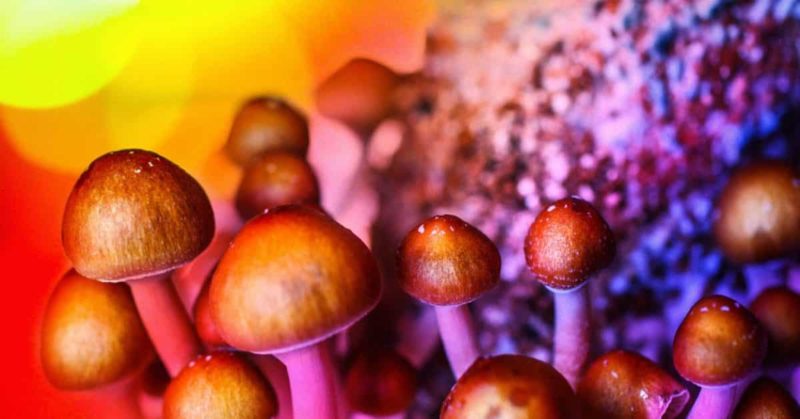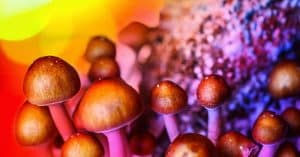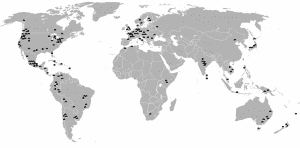
What are Magic Mushrooms? A Primer on a Classic Psychedelic
‘Magic’ mushrooms, also known as psilocybin mushrooms, are a group of fungi that contain psilocybin and psilocin compounds. Psilocybin is one of the most well-known and widely-used psychedelic compounds, according to the Substance Abuse and Mental Health Services Administration.
Table of Contents
History of Magic Mushrooms

People have been ingesting magic mushrooms since the dawn of civilization, if not well before that. The ‘Stoned Ape’ theory of human evolution suggests that psilocybin’s ability to enhance brain function, by re-wiring and expanding the brain’s synapses and neural connections, may have driven the massive growth in the size and computing power of the brain during our long evolutionary timeline, which would mean that humans have been ingesting ‘shrooms’ for millenia. Depictions of mushroom consumption can be found in Stone Age rock art across Europe and Africa, and throughout Central and South America, as shown in pre-Columbian sculptures and glyphs. Often, these depictions showed their use as part of religious or cultural rituals, which, given their effects, is not all that surprising! Although certain cultures have been known to use the hallucinogenic properties of some mushrooms for centuries, the psilocybin compound was first isolated in 1958 by Dr. Albert Hofmann, who also discovered lysergic acid diethylamide (LSD).
The Effects of Magic Mushrooms
Magic mushrooms are hallucinogens, meaning they can cause you to see, hear, and feel sensations that are not real. The hallucinogenic effects that they create are highly variable and influenced by the growing conditions of the mushroom itself, how fresh it was when ingested, the environment in which it was taken and possibly even the culture of the person eating it. Magic mushrooms are often prepared by drying the mushroom and mixing it with food or drink (to mask the taste), although some people have no issue eating freshly picked ‘shrooms. Predicting the strength of magic mushrooms is very difficult, so a ‘start low, go slow’ approach is ALWAYS recommended. For most people, taking a mushroom starts with mild hallucinations or ‘visuals’ – they look at distorted world views, where shapes, colours, sounds, and time all seem strangely different and fascinating.
Related Articles
Learn more about Psilocybin on Frshminds:
- Considering a retreat? Check out Frshminds’ Ultimate Psilocybin Retreat Center Guide.
- What Kind of a Drug is Psilocybin? What Will It Do To Me?
- How Long Does Psilocybin Stay in Your System?
- Don’t Miss the Best Psilocybin Retreats in Amsterdam
- How To Properly Store Magic Mushrooms
- Why Are There Psilocybin Retreats In Mexico?
- Want To Go To A Magic Mushroom Retreat in Jamaica?
- 3 Top-Rated Psilocybin Retreats in Costa Rica
- The Best Psilocybin Retreats: What To Look For
- Psilocybin Retreats in the Netherlands
The effects of a single mushroom can be quite different across different people. A positive experience might lead to giggling euphoria, feeling energized and empowered, a sense of wonder about the distorted world you’re seeing, and other positive impressions. For those less fortunate in their experience, they may panic (obviously, this kind of reaction is more common in more novice users, whose minds are more likely to become concerned or try to reject, the sensations they’re experiencing). Anxiety, a desperate hope that the trip will end soon and even physical illness are common and not typically anything to be concerned about – while the experience is unpleasant, it is not damaging, and the person will recover from it once the trip has receded. It’s also important to be conscious of the mood you’re in when you’re preparing to eat the mushroom, as the experience can take your existing mood and heighten it (so if you’re happy, you may be absolutely elated; if you’re angry, you might just go into a full-on rage!). Larger doses, of course, have more extreme experiences – people who take larger doses have a wide range of experiences and may act unpredictably.
The Legality of Magic Mushrooms
Psilocybin is classified as a Schedule I drug in the United States, meaning that it has a high potential for misuse and has no currently accepted medical use in treatment in the United States. While it is not currently accepted for use, a number of studies at premier medical research institutes around the world are evaluating psilocybin’s effectiveness as a medical treatment for a number of mental disorders, with very promising results.
What is Microdosing

The practice of microdosing is the consumption of small, ‘sub-perceptual’ (not noticeable by the conscious mind) doses of a substance. In the case of psilocybin, microdosing is becoming a popular (though illegal, of course) phenomenon, with practitioners taking small doses on a regular schedule, often daily. Believers state that after a period of time, they see a noticeable increase in their creativity, energy, ability to focus, and interpersonal relationships (though to be fair, there is very little literature to back up these claims, and it is entirely possible that many of these practitioners are subscribing to a placebo effect). There is no guarantee that you will experience any of the effects of microdosing, but the volume of anecdotal reports of the ascribed benefits merit further exploration.
Not all magic mushrooms are created equal. The genera (a biological categorization of the different types of mushrooms) of ‘shrooms that include the psilocybin compound include Copelandia, Gymnopilus, Inocybe, Mycena, Panaeolus, Pholiotina, Pluteus, and Psilocybe. While these mushrooms grow in different environments, look different, and taste different, they all contain the psilocybe and psilocin compounds that create a psychedelic experience when eaten. And these variants of psychedelic mushrooms are available throughout the world (see map), with their availability being a key reason that their use has been so widespread for so long.
The Future of Magic Mushrooms
As with other psychedelic compounds such as ketamine and LSD, psilocybin is under study as a potential treatment for a variety of mental disorders, including depression, addiction and obsessive-compulsive disorder. Over the next several years, there is a very real possibility that psilocybin will be licensed for use, under controlled conditions by medical practitioners, as a novel treatment for these disorders if all other treatment options have failed. And over the decades to come, as the research demonstrates the effectiveness of the product and its limited short- and long-term side effects, the use of magic mushrooms will finally enter the mainstream and bring relief to tens of millions of sufferers worldwide. After being used by humans since the dawn of civilization, it may soon be prime time for magic mushrooms.
Magic Mushrooms 101
If you are looking to get up to speed on magic mushrooms, these articles on Frshminds will get you there in no time:

Comments